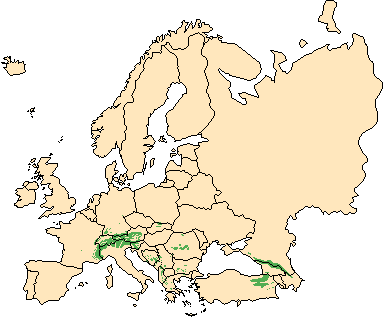![]() Return
to Artiodactyla
Return
to Artiodactyla
Classification
|
 Rupicapra
rupicapra
Rupicapra
rupicapra
Chamois
![]()
Taxonomy
 |
 |
 |
Click on the pictures above for a larger view of the
photographs
|
||
General Characteristics
Body Length: 110-130 cm / 3.6-4.3 ft.
Shoulder Height: 70-85 cm / 2.3-2.8 ft.
Tail Length: 10-15 cm / 4-6 in.
Weight: 14-62 kg / 31-136 lb.The short, smooth summer coat is overall tawny or reddish-brown, while in winter it becomes a chocolate brown, with guard hairs measuring 10-20 cm / 4-8 inches long covering a wooly underlayer. The under parts are pale. The legs are usually darker, and there is a slight mane on the throat. The jaw, cheeks, and nose-bridge are strikingly white, and there is a black stripe running from the eye to the muzzle. The slender, black horns are found in both sexes. Rising vertically from the forehead, they are sharply curved backwards on their top third like hooks, and can reach a length of 32 cm / 12.8 inches.
Ontogeny and Reproduction
Gestation Period: 170 days.
Young per Birth: 1, rarely 2
Weaning: After 6 months.
Sexual Maturity: Females at 2.5 years, males at 3.5-4 years.
Life span: 14-22 years.The young are born in late spring (May-June), and can follow their mothers almost immediately after birth.
Ecology and Behavior
During the summer months, herds of chamois wander alpine meadows above 1800 meters / 6,000 feet in home ranges averaging 74 hectares. As winter approaches there is a general downward shift to lower altitudes (below 1,100 meters / 3630 feet), where the chamois may enter forested regions, although they remain near steep cliffs. When alarmed, chamois speed to the most inaccessible places, making leaps as high as 2 meters/ 6.6 feet and spanning as much as 6 meters / 19.8 feet. Extremely nimble and surefooted, the chamois can travel up to 50 kmph / 30 mph over steep or uneven ground. Alarm signals include whistling through the nose, 'sneezing', and stamping their feet. During the Autumn rut old males make an open-mouthed grunt. These breeding males drive younger males from the maternal herds, occasionally killing them.Family group: Females and young in small flocks of 5-30 animals, adult males solitary.
Diet: Grasses, leaves, buds, shoots, fungi.
Main Predators: Lynx, wolf, bear, fox.
Distribution
Rocky areas and alpine meadows in Europe [especially the Alps, Carpathians] and in Asia minor.

Range Map (Compiled from Shackleton, 1997)
Conservation Status
As a species, the chamois is still common and not threatened. However, several subspecies are on the IUCN's Red List of Threatened Animals (1996). R. r. caucasica is classified as vulnerable and R. r. tatrica as endangered, while R. r. cartusiana is classified as a critically endangered subspecies. There is insufficient data as to the current status of R. r. asiatica.
Remarks
The hide of this ungulate is made into "shammy", a very fine, soft cloth used for polishing. Chamois is French for a wild goat. Rupes (Latin), genitive rupis, a rock or cliff; capra (Latin) a she-goat.
Literature Cited
Nowak, R. M. [editor]. 1991. Walker's Mammals of the World (Fifth Edition). Baltimore: The Johns Hopkins University Press.Shackleton, D. M. [Editor] and the IUCN/SSC Caprinae Specialist Group. 1997. Wild Sheep and Goats and their Relatives. Status Survey and Action Plan for Caprinae. IUCN: Gland, Switzerland and Cambridge, UK.
Walther, F. R. 1990. Chamois (Genus Rupicapra). In Grzimek's Encyclopedia of Mammals. Edited by S. P. Parker. New York: McGraw-Hill. Volume 5, pp. 495-497.
Wilson, D. E., and D. M. Reeder [editors]. 1993. Mammal Species of the World (Second Edition). Washington: Smithsonian Institution Press. Available online at http://nmnhwww.si.edu/msw/
Return to Artiodactyla

![]()
© Brent Huffman, www.ultimateungulate.com |
|
|